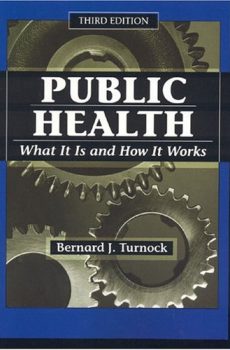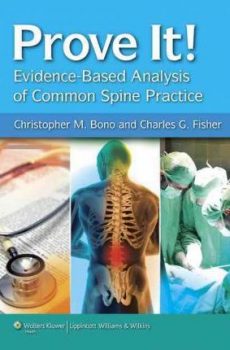
Prove It! Evidence-Based Analysis of Common Spine Practice
10,090.00₹ 2,200.00₹
Prove It! Evidence-Based Analysis of Common Spine Practice offers spine surgeons detailed guidance in using the principles of evidence-based medicine in treatment decisions. The book presents a unique collection of 31 case studies in which noted experts review a patient’s signs and symptoms and relevant images to determine the best-fitting diagnosis and then to develop a treatment plan based on the best available published evidence. The case-based approach allows the reader to see how evidence-based medicine can be directly and practically applied to the care of patients with a variety of disorders
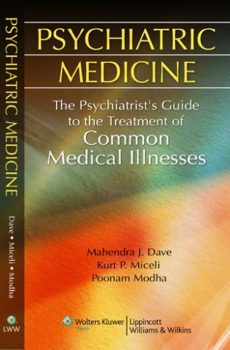
Psychiatric Medicine
3,590.00₹ 1,190.00₹
This handbook is a concise, portable ready reference for diagnosing and treating common medical illnesses encountered in psychiatric patients, particularly those in an inpatient service. The first section explains laboratory tests used to diagnose medical illness. The second section covers 59 medical symptoms and diseases. The third section focuses on important syndromes which have specific psychiatric manifestations or are caused by psychotropic drugs.
Particular attention is given to basic understanding of lab tests and drug dosing. “Pearls” and “pointers” increase the book’s utility. Appendices offer guidelines on monitoring for psychiatric medications and list key medical abbreviations.
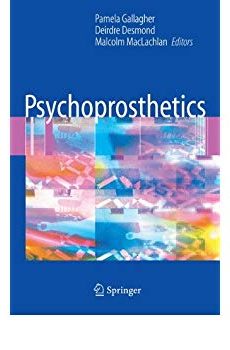
Psychoprosthetics
9,995.00₹ 1,995.00₹
Psychoprosthetics is the study of the psychological aspects of prosthetic use and of rehabilitative processes in those conditions that require the use of prosthetic devices. For people with limb loss, the fitting of a prosthesis can give rise to a variety of issues from functional rehabilitation to quality of life, well-being, participation in society and cosmetic satisfaction. As prosthetic technology continues to become more sophisticated and advanced, there is an onus on those who work with prosthetic users, to be aware of the impact of prosthetics on the ways in which people understand and construct their realities and their attempts to cope with and relate to them. However, despite the broad and increasing interest in psychosocial aspects of prosthetic use and rehabilitation, to date there has not been a complete volume on the topic – this book now addresses that need.
Psychoprosthetics brings together the most recent and exciting research and knowledge in this new field into one easily accessible volume. It contributes to a better understanding of the complex human dynamics involved in prosthetic use and provides an analysis of the practice, research and theory in the field of psychoprosthetics.
Written by some of the leading experts to the field, this informative and cutting-edge text will be of relevance to students, practitioners and researchers from a wide range of disciplines, including prosthetics and orthotics, occupational therapy, physiotherapy, rehabilitation medicine, engineering, nursing and psychology.
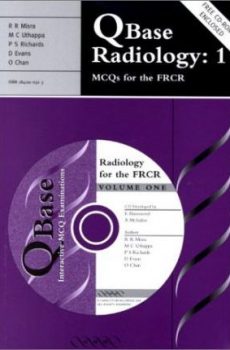
Qbase Radiology 1
3,520.00₹ 2,320.00₹
QBase Radiology 1 and 2 together represent a completely comprehensive resource for all postgraduate and undergraduate trainees in radiology. In combination, the books include 900 multiple choice questions (480 on Volume 1 and 420 on Volume 2) and the free CD-ROMs that accompany both books also contain all 900 MCQs and over 100 high quality radiological images. The powerful QBase examination analysis software allows the reader to attempt the same exams as printed in the book, but on screen, realistically replicating the examination situation. The user can also ‘custom-build’ their own exams based on their own choice of subjects and number of questions, sit an exam that is automatically set by the program using all of the questions on the CD, or they can sit a ‘shuffled’ version of an exam, whereby the question parts (A-E) are reorganised automatically to avoid pattern recognition. The software also allows the user to set their own ‘confidence level’ when taking an exam and it will automatically mark, analyse and store completed exams for future review and re-sitting, allowing the package to be used as a fully interactive self-learning tool.
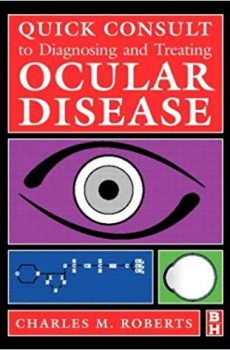
Quick Consult to Diagnosing and Treating Ocular Disease
3,780.00₹ 2,380.00₹
Instantly retrieve the information you need to diagnose and treat common ocular disorders. This reader-friendly, quick reference manual presents a problem-solving approach to diagnosing and treating common ocular disorders encountered in primary care practice. Includes helpful tables and lists for quick and easy access to information such as ocular and systemic drugs.
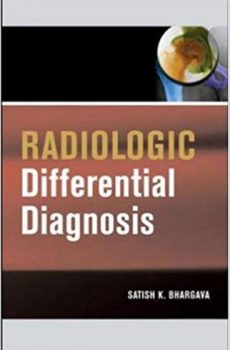
Radiologic Differential Diagnosis
4,620.00₹ 2,990.00₹
This is the perfect quick-reference for the busy radiologist and resident. The most up-to-date resource in the field of radiography, this bulleted handbook provides differentiating features for hundreds of diseases, conditions, and injuries. Readers will find 300 illustrations and radiographs, a streamlined find-it-now format, and exceptional value for the price.

Radiology of the Stomach and Duodenum
16,990.00₹ 6,790.00₹
A number of imaging techniques, many of them complementary, are used in the investigation and treatment of disorders of the stomach and duodenum. Optimal patient treatment requires a thorough knowledge of the application of these techniques, as well as a sound understanding of pathology of the stomach and its presenting symptomatology. This well-illustrated book covers the various investigative methods in detail, discussing their advantages and disadvantages and explaining their role in specific settings. It will be of great value to both trainee and experienced radiologists, and should assist in promoting effective and judicious patient management.

Radiology Picture Tests
3,900.00₹ 2,700.00₹
A comprehensive, systemically organised ‘film viewing’ book designed specifically for FRCR candidates but equally useful to all trainee and junior radiologists as an ‘aide memoire’ and to medical undergraduates and MRCP candidates as a useful means of self-testing their level of knowledge. It is fully illustrated with high-quality, clearly labeled black and white illustrations throughout and the text closely mirrors the way that questions are asked in the FRCR film viewing examination, so as to provide as real an examination experience as possible. Each section of the book contains 20 representative questions, and model answers, providing 200 cases altogether.

Radiology Review Manual
6,900.00₹ 990.00₹
This succinct yet complete presentation of radiologic diseases includes all relevant findings and differential diagnoses for every body region. Similar to previous versions, the fourth edition is organized by body system and is presented in an outline format with line drawings and mnemonics for remembering diagnoses.

Radionuclide Peptide Cancer Therapy
12,995.00₹ 9,300.00₹
Offering lower toxicity and higher accuracy than conventional therapies, this source offers illustrative coverage of this new method to treat tumors associated with brain, breast, lung, and neuroendocrine cancers. Accompanied by a CD offering color images, radiolabeling procedures, and tips on radiopharmceutical administration, this source will offer comprehensive and expert guidance on this burgeoning therapeutic technique.
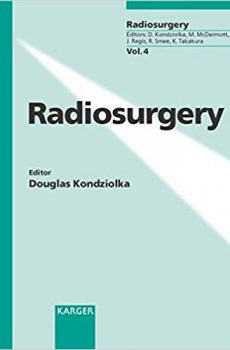
Radiosurgery
20,560.00₹ 7,200.00₹
Covering the proceedings of the 5th international stereotactic radiosurgery society meeting, this volume includes essays on vascular malformations, benign tumours, malignant tumours, functional disorders and areas of physics and radiobiology.

Review of Surgery: Basic Science and Clinical Topics for ABSITE
4,720.00₹ 1,300.00₹
This book provides an invaluable study aid for all general surgery residents preparing for the American Board of Surgery In-Training Examination (ABSITE). Concisely written overviews of each topic covered on the exam combined with the self-test format offer a new and innovative approach. Each chapter is a short summary of a basic science or clinical topic and includes hundreds of related questions like those found on ABSITE. The book is targeted to trainees at various levels and also can be used to prepare for the qualifying (written) and certifying (oral) exams given by the American Board of Surgery upon completion of training.
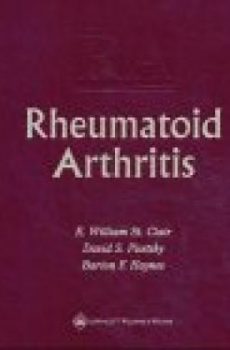
Rheumatoid Arthritis
10,900.00₹ 2,500.00₹
This authoritative clinical reference provides comprehensive coverage of all aspects of rheumatoid arthritis. The basics of rheumatoid arthritis are thoroughly covered in order to provide a firm foundation for the main focus of the text: therapy and clinical management of the disease. Practitioners will find detailed information on both pharmacologic and nonpharmacologic courses of management, with special emphasis on the management of pain. More than 100 full-color illustrations provide clear visual support for the concepts in the text. Online references in each chapter, as well as an entire chapter on Web-based information resources, keep this book on the cutting edge of this rapidly evolving field.
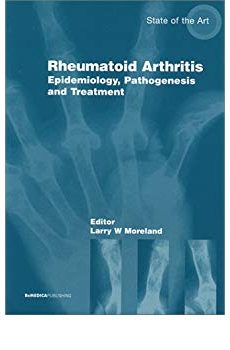
Rheumatoid Arthritis: Epidemiology, Pathogenesis and Treatment
1,890.00₹ 910.00₹
“…Rheumatoid Arthritis: Epidemiology, Pathogenesis and Treatment, focuses on several pertinent issues regarding rheumatoid arthritis. The editor…and individual chapter authors are leaders in their field and have captured the essence of some of the most important issues in the undrstanding of the relationship between pathophysiology of rheumatoid arthritis and its modern treatment… The book is well written in a way that will be useful for several years, because it anticipates the introduction of some new drugs that are not yet available, and it gives appropriate background to understand what their place may be in the therapeutic armamentarium. Overall, this book is well written, consistent, easy to read from cover to cover in a short period of time or flip through to check on various concepts.” Eric P Gall MD, FACP, FACR, writing in the Journal of Clinical Rheumatology
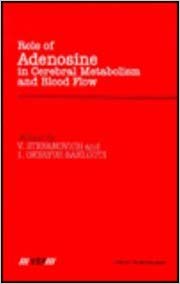
Role of Adenosine in Cerebral Metabolism and Blood Flow
9,690.00₹ 4,600.00₹
It is becoming increasingly realized that adenosine plays an important role in the central metabolism and blood flow and that therapeutic possibilities may arise from the pharmacological manipulation of the adenosine system. The growing interest in this field has prompted a group of international experts to contribute to this volume on adenosine. The book contains thorough reviews on adenosine research and presents numerous new ideas and data on the role and function of adenosine in the mammalian brain.
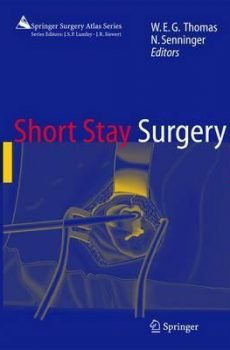
Short Stay Surgery
22,399.00₹ 15,700.00₹
An ever-increasing number of surgical procedures are now being performed in ambulatory settings. Hospital beds are at a premium and resources are becoming scarcer. This atlas guides readers through all the practicalities: it looks at the potential of short-stay surgery, how to set it up and how it may be relevant to all surgical specialities. Specialists well known in their sphere discuss and illustrate operations that can be performed without a stay in hospital. The topics covered will become more and more relevant as time goes by, and those who read this book will be able to stay well ahead of the game. It is designed to help surgeons plan for the future and discover the vast potential for this form of surgery.
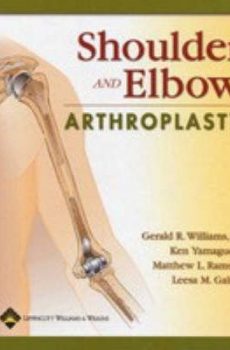
Shoulder and Elbow Arthroplasty
15,900.00₹ 3,850.00₹
Written by the world’s foremost shoulder and elbow surgeons, this volume is the most comprehensive, current reference on shoulder and elbow arthroplasty. The book provides state-of-the-art information on implant design and detailed guidelines—including treatment algorithms—on specific arthroplasty procedures for arthritis, fractures, chronic dislocations, and other disorders. More than 400 illustrations complement the text.
Each main section—shoulder arthroplasty and elbow arthroplasty—has three subsections: implant considerations, technical considerations, and disease-specific considerations. Disease-specific chapters cover surgical anatomy, pathophysiology, preoperative evaluation, indications for surgery, implant choices, surgical techniques, and postoperative rehabilitation. Also included are chapters on complications, revision arthroplasty, arthroplasty with bone loss and limb salvage, and alternatives to replacement arthroplasty. Every chapter includes a “Chapter-at-a-Glance” summary for easy review of the chapter content.
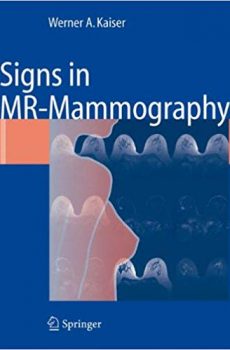
Signs in MR-Mammography
13,200.00₹ 4,990.00₹
Breast cancer is the leading cause of cancer-related deaths in women, and its prevalence has been steadily rising in recent decades. This book describes morphologic and kinetic signs that are important in the analysis of breast MR images before and after contrast administration and in various pulse sequences. It will help broaden the clinical application of MRM so that as many physicians as possible can make more accurate diagnoses.
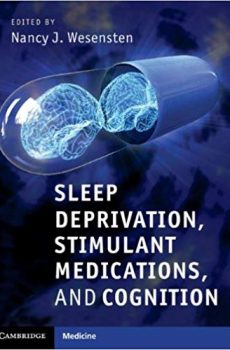
Sleep Deprivation, Stimulant Medications, and Cognition
8,990.00₹ 2,970.00₹
Sleep Deprivation, Stimulant Medications, and Cognition provides a distillation of the literature surrounding stimulant medications and cognitive performance, with an emphasis on critical evaluation of the potential practical utility of these agents for restoring and maintaining cognitive performance in sleep-deprived individuals – key reading for researchers interested in sleep loss and psychopharmacology.





